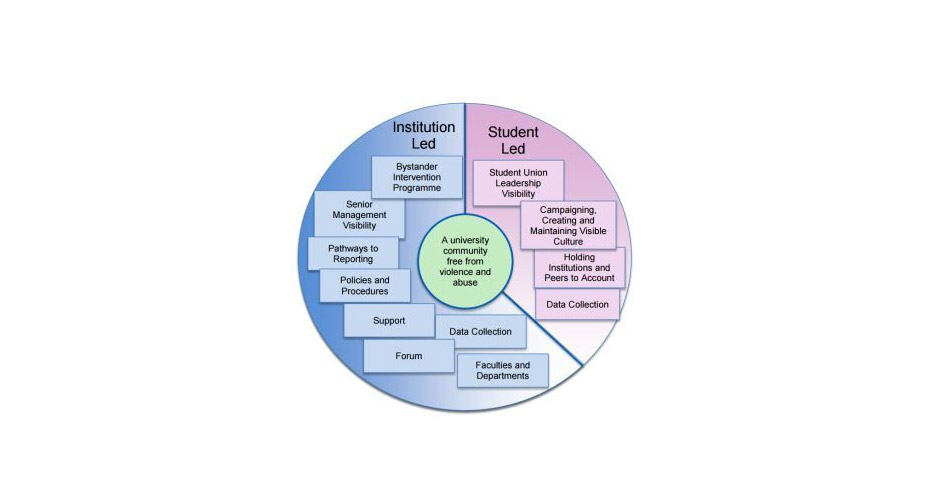Fenton, R.A. and Mott, H.L. (2015) Strategy for Addressing Sexual and Domestic Violence in Universities: Prevention and Response. Bristol: University of the West of England. Available online.
Related links
Addressing sexual and domestic violence
This page summarises the essential elements of an effective strategic approach to preventing, and responding to, sexual and domestic violence against women and related forms of violence and abuse in university settings.
Strategy for addressing sexual and domestic violence in universities: prevention and response
In order to respond to their institutional responsibilities, universities should address:
- Prevention.
- Policy.
- Monitoring and reporting.
- Providing and signposting specialist response and support pathways.
- Fostering culture change – which is key to preventing violence against women.
In addition to this institutional response, it is important for student unions and other student–led organisations to work in conjunction with universities particularly in regard to shaping culture change.
University led
Universities must consider how they comply with their Public Sector Equality Duty under s.149 of the Equalities Act 2010 and their duties under the Human Rights Act 1998.
More information to be found here: view of the Ombudsman.
An evidence-based bystander intervention programme which adheres to public health prevention criteria for the prevention of violence against women is timetabled and delivered to all students by trained facilitators. Facilitators are disclosure trained. Students in leadership positions (e.g. student representatives or mentors, students holding a position at the union) are required to have completed the bystander intervention programme.
The additional social returns of a bystander programme relating to enhancing student employability, enriching the student experience, and furthering education for sustainable development, are recognised and endorsed.
Example: The Intervention Initiative commissioned by Public Health England and advocated by HM Government.
Senior leaders are seen and heard promoting an institution-wide culture of zero tolerance to violence; sponsoring positive action across their areas of responsibility in all aspects of university life. Example: zero tolerance pledge
Every academic faculty/department has in place an academic representative or champion who has received disclosure training, as a first point of contact for students and staff. The champion is trained to carry out risk assessment and is supported in this role. The champion’s role and contact details are readily accessible and can be clearly identified on the pathway to reporting (see below).
All staff with personal tutor responsibility, as well as departmental managers, have had basic awareness training in how to be a first responder, and are familiar with the pathway. All staff understand the importance of confidentiality. Example: awareness raising and disclosure training at departmental away days.
There is a clear policy statement that specifically addresses all forms of violence and abuse against women, including behaviour that constitutes a ‘conducive context’. Example: UWE and UWESU Joint Policy Statement. Sanctions are enforced against individuals, clubs or societies breaching expected good conduct.
Straightforward and transparent processes for handling reports from, and concerning the behaviour of, students and staff, are in place and readily accessible. These processes are victim-centred with due regard to fair treatment of those accused. External support for universities as employers is available. Example: The Corporate Alliance.
Students and staff are readily able to locate a user-friendly step by step map or pathway (i.e. a diagram) indicating their options for reporting violence and abuse that they have endured or witnessed. It includes clear information about what will happen, and how to access support whether or not they choose to make a report (see below: support).
In addition to being searchable online, pathways are available to students through familiar subject resource hubs such as Blackboard.
Confidential support for victim/survivors is available from trained specialists within the institution. The specialists are trained in risk assessment and supported in this role. What this support consists of, and how it can be accessed, are clearly documented. Referral pathways (to counselling and other provision) are clearly set out.
Specialist support in the local community and via national agencies is also clearly identified for staff and students, friends and family. Example: support pages.
Universities have a centralised system for recording reports made internally (e.g. to staff in accommodation; departments; student services) and externally (e.g. to police; service providers in the community).
In the knowledge that most violence and abuse is not formally reported, universities commission or conduct standardised surveys of their student experiences of violence and abuse.
University and student leaders, together with service providers and criminal justice agencies, work together intelligently so that knowledge, resources and plans are shared.
Student led
Union leaders are trained and they promote training for clubs and societies in creating and maintaining a zero tolerance culture for violence.
Leaders are seen and heard promoting this culture and sponsoring positive action across their areas of responsibility in all aspects of university life.
Example:UWE and UWESU Joint Policy Statement.
Union leaders implement NUS initiatives and develop institution-specific campaigns and social norms marketing initiatives.
Example: NUS: I heart consent; UWE Anti-Abuse Campaign; Know Your Power social norms marketing.
Unions shine a light on the actions (or inactions) of the university as an institution. Union leaders hold their clubs and societies to account for breaches and violations of expected good conduct.
Example: LSE response from Union and Equality Forums to sexist, homophobic leaflets. Expectations for good conduct are made clearly visible and accessible for all students by the unions.
All students are prosocial bystanders who intervene to ensure that their community is free from violence and abuse. All students will themselves adhere to expectations of good conduct and will challenge and report any problematic behaviour of their peers.
The Students’ Union has a centralised system for recording, monitoring and referring onwards, reports made to them. In the knowledge that most violence and abuse is not formally reported, unions, in conjunction with universities, will commission or conduct standardised surveys of their student experiences of violence and abuse or support universities in so doing.
Download a PDF version of the Strategy for addressing sexual and domestic violence on universities.

